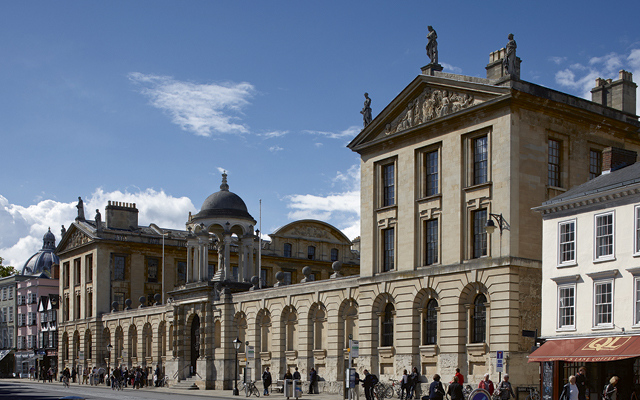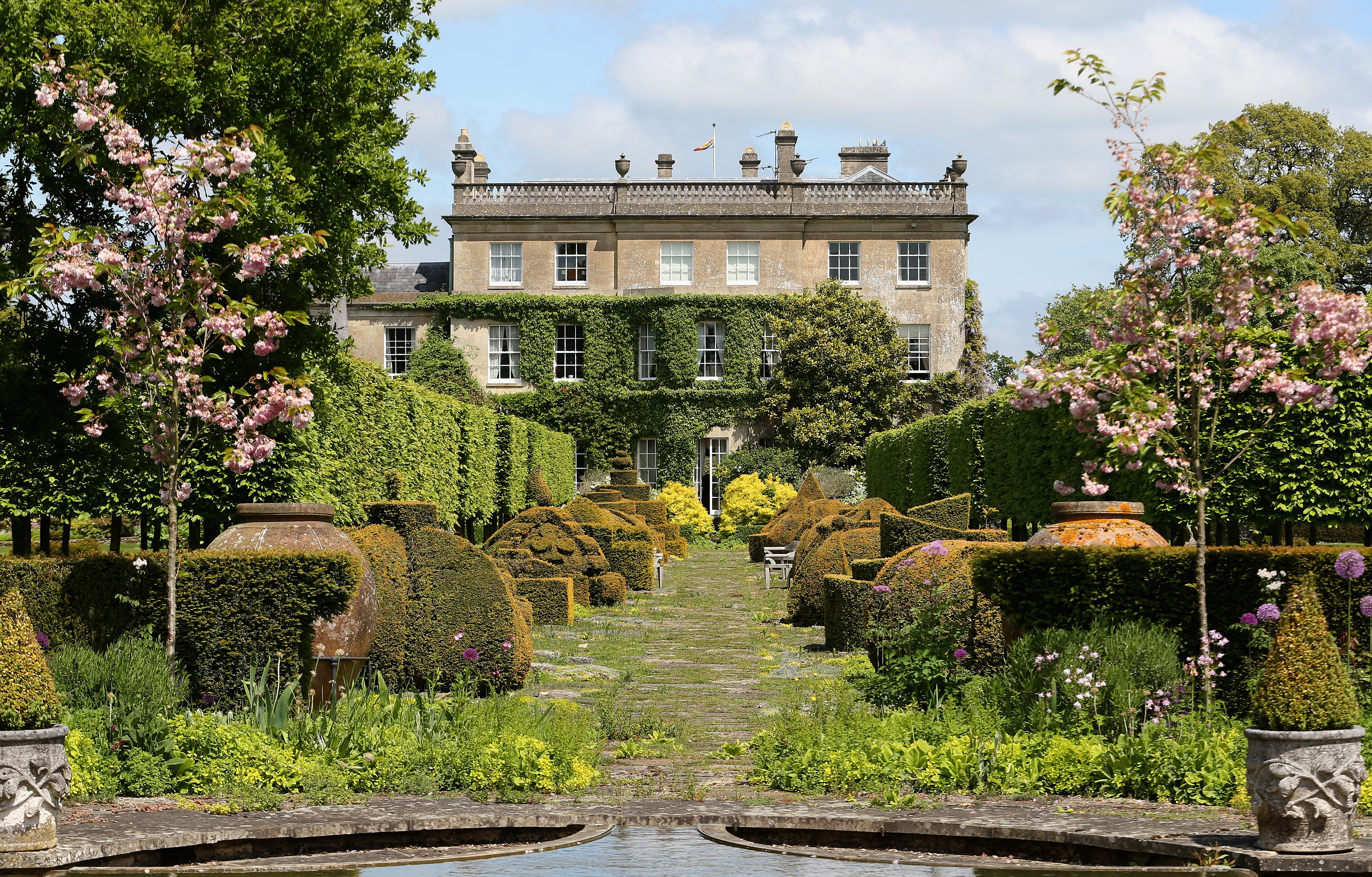Queen’s College, Oxford
Oxford’s greatest neo-classical college has been recently restored. Geoffrey Tyack pays a visit to find out its unexpectedly complex history.


Oxford’s High Street has long been recognised as one of the most beautiful urban thoroughfares in Europe. And one of its landmarks is the bold 18th-century façade of The Queen’s College. Beyond the first quadrangle that it encloses, and invisible from the High Street, is the Library, built in 1692–6 and restored in 2013–4.
The successful completion of this project provides an excellent opportunity to revisit Queen’s as a whole, the most complete set of neo-Classical collegiate buildings in Oxford and, in the words of one contemporary, ‘one of the most Majestick pieces of Architecture in the whole Kingdom’.
Queen’s is one of the oldest colleges in Oxford and, in the 17th century, it became one of the most populous. Founded in 1341, it gradually acquired a collection of domestic-looking buildings now entirely vanished arranged around a small quadrangle entered from Queen’s Lane, running north from the High Street.
The first major extension to these modest buildings came in 1671–2, when a block of classically proportioned rooms went up to the north. Designed to house the growing number of commoners fee-paying students not on the original foundation it was funded, at least in part, by one of the college’s most generous donors, Sir Joseph Williamson, son of a clergyman from Cumberland the county from which Queen’s recruited many of its members and head of Charles II’s intelligence service; his other gifts to the college included a massive silver trumpet used to call members to dinner.
Williamson was a member of the recently founded Royal Society and the design was supplied by a fellow member, Sir Christopher Wren; subsequent rebuilding has meant that little of his work remains, but its plain, good proportions set the tone for what was to come later.
In 1692, following a bequest of books from Thomas Barlow, Bishop of Lincoln and former Provost, the new Library went up facing the Williamson Building across what was to become the college’s Back Quadrangle. Built of local stone, it is raised up on an open, rusticated arcade and is flooded with natural light from large round-headed windows. On each façade, there is an engaged temple-front with a stone eagle the college symbol crowning the pediment.
The eastern pediment, recently restored in Bath stone by Cliveden Conservation, contains a female figure of Wisdom surrounded by cherubs, books and mathematical instruments a tangible expression of the concept of a college library as a repository of the accumulated wisdom of the ages.
Sign up for the Country Life Newsletter
Exquisite houses, the beauty of Nature, and how to get the most from your life, straight to your inbox.
The interior owes much of its cheerful, almost festive, character to its craftsmanship. The bookcases, embellished with carved swags, are by the joinery team of Thomas Minn, father and son. A London craftsman, James Hands, was responsible for the trails of deeply moulded plasterwork framing the panels on the ceiling. The panels were probably intended for paintings, but were left empty until 1756, when the talented Oxford plasterer Thomas Roberts filled them with Rococo work, including a recently gilded sunburst framed by a wreath of leaves.
The plasterwork over the windows, featuring plants and scientific instruments, is by Johannes Vanderstein, a pupil of Grinling Gibbons, who had recently worked in Trinity College chapel, another superb Oxford interior of the 1690s. Vanderstein was probably also responsible for the south doorway pediment.
Queen’s library was not designed by a single person. Surviving accounts show that John Townesend, founder of Oxford’s most successful dynasty of mason-contractors which still survives as Knowles & Son, contractor for the recent renovation made a drawing of ‘the cloisters’ and supplied a plan for the whole college ‘if new modeled’: an indication that further building was already contemplated in the 1690s.
That does not mean that Townesend was the architect in the modern sense it is more likely that a design was initially supplied by an unknown person, perhaps the Provost, Timothy Halton, who contributed a third of the cost. It was then sent for amendment to ‘learned judges in architecture’ before being turned over to Townesend.
An engraving by Michael Burghers of a preliminary design survives in the collection of Henry Aldrich, Dean of Christ Church, and Aldrich who later designed Peckwater Quadrangle at Christ Church (Country Life, Dec-ember 5, 2012) or even Wren, who had already designed a building for Queen’s, may have helped to produce the dignified façades that we see today. This collaborative approach was to continue into the 18th century, when the college embarked on more ambitious plans to replace its medieval buildings.
With the Library completed, in 1706–8, Townesend closed the Back Quadrangle with a plain three-storeyed north range of student rooms. Then, following a legacy of £6,000 from Williamson and the acquisition of a row of houses that hid the old college from the High Street, attention turned to the creation of a new Front Quadrangle, containing a new Hall and Chapel and extending south to the street.
Before settling on a design, the new Provost, William Lancaster, sought advice from George Clarke, MP for Oxford University and a Fellow of All Souls College. After losing his post as Secretary to the Admiralty in a political reshuffle in 1705, Clarke had settled in Oxford and had taken over Aldrich’s informal role as architectural advisor to the University.
While at the Admiralty, he had encountered Wren’s pupil and draughtsman Nicholas Hawksmoor, who was working on the building of Greenwich Hospital and, in 1708 or 1709, Hawksmoor supplied a series of ingenious and highly creative designs for Queen’s. Other designs, now in the library of Worcester College, were prepared by Clarke himself, some of them proposing to place the Hall and Chapel in a massive block fronting the High Street.
In the end, the Hall and Chapel the spiritual and physical core of the college were placed in a range to the south of the Back Quadrangle, with two long wings extending to the High Street, which would be closed off by a screen and porter’s lodge. Writing in 1723, John Aycliffe, a Fellow of New College, claimed that the new Quadrangle would, when completed, be ‘erected on the Plan of Luxemburgh-House [the Palais du Luxembourg] at Paris, with stately Cloysters on the side of each Wing, and the Chappel and hall in the Front thereof lying open to the publick View of the High Street. This Model was projected by the Reverend Doctor Lancaster… A Person of a publick Spirit equal to the Design of this vast Undertaking.’
Lancaster, a fashionable preacher who contributed £4,000 of his own to the new buildings, had been sent to Paris by Williamson as a young man and his engraved portrait by George Vertue shows him with a drawing of the High Street front much as it is now. He should, therefore, be seen as the initiator of, and guiding spirit behind, the buildings that we now see.
It remained, however, to work out the details of the plan and elevations and here, Lancaster turned to Townesend’s son William, the master mason at Peck- water Quadrangle, who had been sent to France by his father as young man and who was described in the Queen’s accounts as an ‘architecto’.
Work began on the west wing in 1709–11, the internal façade clearly derived from Hawksmoor’s ‘Proposition A’, still preserved in the college archives. The new Hall and Chapel range followed in 1714–19 in the spirit of Wren’s Royal Hospital Chelsea, although in a grander, more majestic, vein. The sculpture in the pediment, designed by Sir James Thornhill, displays a seated Britannia holding the balance of power: a clear reference to the triumph of the newly formed United Kingdom in the recent wars against France, and a prudent gesture of loyalty by a notoriously Tory college and university to the new Hanoverian dynasty.
The somewhat awkward junction of this range with the wings suggests that the design was conceived independently of the other buildings by Townesend and Clarke, perhaps after further contact with Hawksmoor, who had recently worked closely with Lancaster in the building of the University’s Doric-porticoed Printing House (the Clarendon Building) next to Wren’s Sheldonian Theatre.
The interiors of the Hall and Chapel are as stately as the façade, the Hall barrel-vaulted (and recently repainted); on the entrance side, there are arched openings into a first-floor gallery from which, according to Thomas Salmon’s The Present State of the Universities (1744), curious visitors could peer over an iron balcony ‘to see the Society at Dinner’.
The Chapel is reached from the passage leading under the central pediment into the Back Quadrangle. The main body is separated from the small antechapel by a serliana-like wooden screen of 1723, with paired Corinthian columns supporting a central arch, similar to the screen recently installed by Thornhill in the chapel at All Souls College. The apsidal chancel is flanked by Corinthian pilasters, contrasting with the Doric severity outside.
The most remarkable feature of the Chapel is its 16th- and 17th-century stained and painted glass, refitted from the former chapel and restored by Joshua Price in 1715–17 in an attempt to preserve the memory of the college’s medieval origins. The four western windows, including one of the crucified Christ suspended from a lily plant, date from 1518; the remainder, with the exception of the east window, of the Nativity, by Price, were supplied in 1635 by Abraham van Linge, widely employed in Charles I’s Oxford.
The virtually unprecedented decision to include a set of earlier stained-glass windows in a new building give Queen’s chapel a special character that sets it aside from any other English place of worship of the period.
Lancaster had provided Queen’s with a magnificent plan for its new buildings, but, after his death in 1717, the college lacked the means to complete it. Appeals to old members and other benefactors were launched in 1719 and 1730, but the east range of the Front Quadrangle externally a mirror image of its western counterpart was only finished in 1759. In 1733–4, following a donation from Queen Caroline, the art-loving consort of George II, the screen wall to the High Street went up under the supervision of the elderly Hawksmoor, closely following a design prepared by Clarke in 1708 or 1709. With the completion of the northern parts of the east range in the late 1750s, the rebuilding of the college came to an end.
Unlike most Oxford colleges, Queen’s built virtually nothing in the 19th and early 20th centuries. C. R. Cockerell filled in the open arcade of the Library in 1843–5, supplying new bookcases, which have been carefully conserved as part of the recent restoration, and there were some repairs to the crumbling external stonework. Then, in 1958–9, a neo-Georgian Provost’s Lodgings was built to the designs of Raymond Erith, facing New College Lane, and a splendid new Baroque-style organ by Frobenius was installed in the Chapel in 1965.
Much of the remaining Headington stone facings were replaced by Clipsham stone in the 1950s and 1960s and, more controversially, the startlingly original Florey Building by James Stirling went up on a detached site over Magdalen Bridge in 1968–71.
More recently, the local firm of Berman Guedes Stretton has ingeniously fitted a new kitchen and a dining room for senior members into an empty space north of the Hall and, in 2012, the company built a new auditorium in the college garden, neo-vernacular in character, with a roof of reused local Stonesfield slates and a light and spacious wood-panelled interior.
The college, however, still derives its visual identity from its 17th- and 18th-century buildings and it is gratifying that their careful conservation in recent years has secured them for our enjoyment and for the benefit of future generations.
* Follow Country Life magazine on Twitter
-
 Spam: The tinned meaty treat that brought a taste of the ‘hot-dog life of Hollywood’ to war-weary Britain
Spam: The tinned meaty treat that brought a taste of the ‘hot-dog life of Hollywood’ to war-weary BritainCourtesy of our ‘special relationship’ with the US, Spam was a culinary phenomenon, says Mary Greene. So much so that in 1944, London’s Simpson’s, renowned for its roast beef, was offering creamed Spam casserole instead.
By Country Life
-
 Sanderson's new collection is inspired by The King's pride and joy — his Gloucestershire garden
Sanderson's new collection is inspired by The King's pride and joy — his Gloucestershire gardenDesigners from Sanderson have immersed themselves in The King's garden at Highgrove to create a new collection of fabric and wallpaper which celebrates his long-standing dedication to Nature and biodiversity.
By Arabella Youens